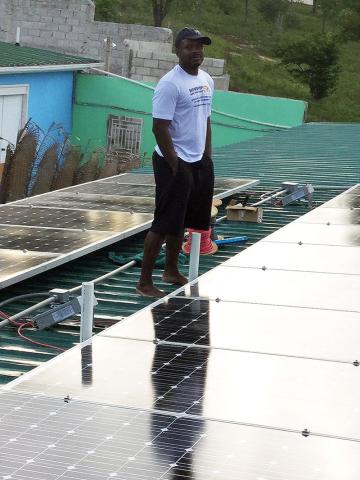Native Haitian Patrick Pierre completed a journey that was years in the making on a recent trip to install microgrid systems in a remote village in his homeland.
The past 16 years of recent graduate Patrick Pierre’s life have been scattered with seemingly random intersections with the Georgia Institute of Technology. Pierre, who earned his bachelor’s degree in electrical engineering this past spring from the School of Electrical and Computer Engineering at Georgia Tech, grew up in Ouanaminthe, Haiti, near the northern border with the Dominican Republic. He returned to his country right after graduation to put his education to practice, but not before taking a circuitous route that eventually brought his journey full circle.
Pierre didn’t always want to be an electrical engineer. His talent in math actually led him down a different path. His first bachelor’s degree was in economics from the State University of Haiti where he was the school’s top student. He imagined that he would pursue a position in business management or possibly enter an MBA program with a scholarship offered by the Haitian government. In order to get ready for the next steps in his career, he attended a language institute at Georgia Tech in 2000 where he spent two semesters learning English. Upon his return to Haiti, he was devastated to learn that his scholarship for graduate study had evaporated due to political unrest.
Discouraged and unsure what to do next, he moved back to the United States where he had some family and hoped he could build a better life with more opportunities than he could find in Haiti. Pierre worked at a number of jobs in Florida and Massachusetts and eventually met his wife, who is also Haitian, in Boston. Life was stable, but something was still missing.
“I looked at how Haitian immigrants in the States lived. Most couldn’t use their degrees and were working two or three jobs just to survive. They were never home; they never saw their kids,” said Pierre.
In order to provide the kind of life that he wanted for his family, Pierre realized that he needed to go back to school. He enrolled in Hillsborough Community College in Tampa, Florida, and essentially started over. He took calculus and physics courses and began studying for an associate’s degree while working full-time. Toward the end of his program at Hillsborough, Pierre went back to Haiti for a visit. It was then that he had his “light bulb moment.”
“Growing up, I remember studying by the light of a kerosene lamp. Going back in 2010, I saw the same struggles that I dealt with as a kid. Most homes still didn’t have reliable access to electricity. People’s quality of life hadn’t really improved at all in the years since I was young,” said Pierre.
The path became clear to Pierre—he would get a degree in electrical engineering so that he could do something to help countries like Haiti. While weighing his electrical engineering program options (he was considering both Georgia Tech and the University of South Florida), he saw something on the Georgia Tech website that cemented his decision. Following the devastating Haitian earthquake in January 2010, Pierre saw an announcement on Georgia Tech’s website for a campus-wide vigil.
“I knew then—those are my people, that will be my academic home,” said Pierre.
The years at Tech were tough, but Pierre’s desire to earn a degree that could be used to help improve people’s lives kept him going.
“If it was just for me, I would probably have dropped out. But it was bigger than me. I got an EE degree to be a voice for people in countries like Haiti,” said Pierre.
Fast forward to spring 2016 and Pierre was on the cusp of gaining his electrical engineering degree when a serendipitous opportunity presented itself. Teams of students in the IEEE Power and Energy Society and the Opportunity Research Scholars Program were traveling to Haiti to install solar-based microgrid systems in a remote village called Thoman. The systems would provide cheap, reliable power to people who either had none or relied on expensive diesel generators. Pierre knew he had to go.
Helping with the installation, as well as acting as an unofficial translator, Pierre was an oddity to some of the villagers, especially the children.
“The kids were really interested in all of the visiting engineers and would flock to us. Because I spoke Creole (the native language of Haiti) as well as English, they didn’t know what to make of me. I overhead them asking each other, ‘Is he one of us or one of them?’ The adults in Thoman said it was the first time they had seen a Haitian come to help,” said Pierre.
In a few weeks, Pierre and his wife and daughter will move to Miami where he has a job waiting with Florida Power and Light. He hopes to continue the work that was started in Haiti and is open to the possibility of leading more projects there in the future. For now, he is satisfied with the way his Georgia Tech journey brought him back to his roots.
“I like to use an electrical engineering analogy to describe my experience. When you build a circuit, you always have to come back to close the loop if you want it to work. That’s the best way to describe my journey so far,” said Pierre.
Images: 1) Jiaqing Li and Patrick Pierre hang with the Thoman locals. 2) Patrick Pierre on the Thoman health center roof.
Additional Images

